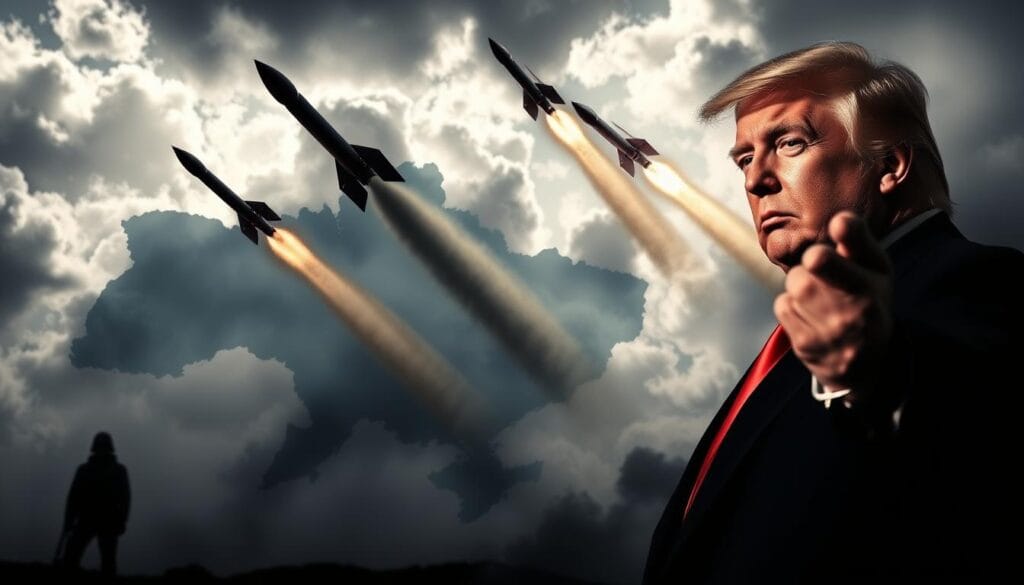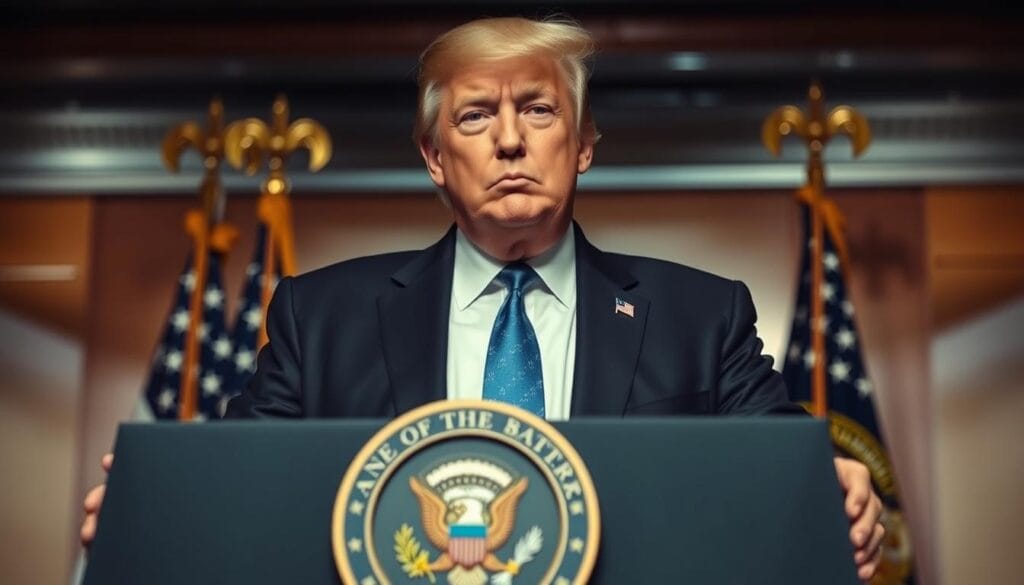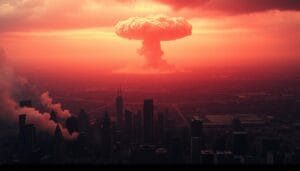Trump Vows Missile Intervention in Ukraine War if conflict continues
Former President Trump vows missile intervention in the intensifying Ukraine conflict if hostilities persist. Read the latest developments now.

Trump Vows Missile Intervention
Click to summarize this article.
Trump Vows Missile Intervention: President Donald Trump has made significant changes in U.S. policy toward Ukraine. He said he might send Tomahawk missiles to Ukraine if Russia doesn’t stop the war. He called these missiles “very offensive” and said they could help pressure Vladimir Putin.
Trump talked about a call with Volodymyr Zelenskyy. They discussed air defense, staying strong, and getting long-range weapons like ATACMS. He said this was a way to negotiate, not a final decision, because of the growing tensions with Russia and attacks on Ukraine’s power grid.
His words matched a story in the Independent about the changing stakes and possible Tomahawk missiles to Ukraine. He said even the threat of these missiles could start talks. He also mentioned he has “sort of made a decision.”
Trump Vows Missile Intervention Key Takeaways
- Air Force One remarks suggest possible Tomahawk shipments if the conflict persists.
- Volodymyr Zelenskyy’s call highlighted air defense, long-range weapons, and ATACMS.
- Signals a possible U.S. policy shift on Ukraine amid rising U.S.–Russia tensions.
- Ukraine power grid attacks raise urgency as winter energy risks grow.
- Leverage-focused approach aims to pressure Vladimir Putin without a firm commitment.
- Any move on Tomahawk missiles to Ukraine could reshape battlefield reach and talks.
Context and Latest Developments in the Ukraine War
The war in Ukraine is getting more intense. Ukraine’s air defense and energy systems are under considerable pressure. Leaders on both sides are pushing their limits, and U.S.–Russia relations are getting worse.
Air Force One remarks: signaling possible Tomahawk shipments
Donald Trump made a big statement on Air Force One. He said the U.S. might send Tomahawk cruise missiles to Ukraine if the fighting doesn’t stop. He wants to make the Kremlin think twice without taking immediate action.
This idea is part of a bigger debate. It’s about whether long-range weapons can stop attacks on energy systems. It also prompts people to consider the risks of escalating the conflict and how to strike a balance between urgency and caution.
Call with President Zelenskyy: Air Defense, Resilience, and Long-Range Capabilities.
Following a meeting with President Volodymyr Zelenskyy, both sides plan to enhance Ukraine’s air defense and power grid. In an interview on Fox News Sunday Briefing, Zelenskyy mentioned working on layered defenses and targeting military targets with longer-range weapons.
The conversation covered Tomahawk cruise missiles and other long-range weapons. They talked about everything from interceptors to power restoration kits. This highlights the importance of protecting both the battlefield and civilians.
Russia’s overnight strikes on Ukraine’s power grid and winter energy risks
Russia attacked Ukraine’s power grid overnight, making things worse before winter. These attacks could lead to a big energy crisis in Ukraine. The country is preparing by fixing the grid, generating emergency power, and protecting substations.
As winter gets colder, officials fear blackouts could happen again. They need stronger defenses and spare parts to avoid this. The debate over Tomahawk cruise missiles is getting more urgent with each attack on critical infrastructure.
Kremlin reaction: “extreme concern” and implications for U.S.–Russia ties
Kremlin spokesperson Dmitry Peskov expressed extreme concern about Tomahawk missiles. He warned that this could harm U.S.–Russia relations. Moscow sees giving Ukraine these weapons as a step towards war and a threat to fragile diplomatic ties.
Experts say this tension is happening during Europe’s deadliest war in decades. Tomahawks are seen as key in this conflict. For more on this tense moment and Moscow’s stance, see this brief on escalation warnings in the Ukraine war.
Trump Vows Missile Intervention
The debate over missiles now defines the tempo of the war. Recently, Tomahawk pledge quotes have framed a sharp, conditional threat. This is designed to build leverage on Putin while signaling a U.S. Ukraine policy shift. Supporters argue that the long-range strike capability could stiffen deterrence against Russia without committing to action today.
“If the war is not settled, I’m going to send them Tomahawks” — key quotes
He used firm but careful language: “If the war is not settled, I’m going to send them Tomahawks,” paired with a clear conditional threat—“We may not, but we may do it.” These Tomahawk pledge quotes were aimed at Moscow as much as they were at Kyiv. They hint at leverage on Putin while leaving room to pull back.
In public remarks, he cast the missiles as a capability Russia “does not need,” underscoring deterrence against Russia. The phrasing echoes his recent comments in news coverage. It highlighted how the warning could be delivered directly if talks stall.
Why Tomahawks matter: range, deterrence, and strategic pressure on Moscow
Tomahawks bring long-range strike capability that reaches deep into Russian-held territory. With a range near 1,500 miles, they can threaten depots, command nodes, and energy sites. This raises costs for the Kremlin.
Strategically, ATACMS vs Tomahawk is about endurance and depth. ATACMS hits hard at shorter distances, while Tomahawks stretch the map and complicate air defenses. The Kremlin’s “extreme concern” and warnings about escalation risks demonstrate why even a conditional threat can alter the bargaining space.
Policy shift: from calls for concessions to the belief that Ukraine can regain territory
His stance has evolved into a sharper shift in U.S.-Ukraine policy. Early calls for concessions gave way to a view that Ukraine can regain territory. This increases leverage on Putin.
As senior Ukrainian envoys plan Washington meetings, signals matter. The mix of Tomahawk pledge quotes and operational options suggests a wider play. It applies pressure, tests openings, and keeps coalition momentum without automatic escalation.
Balancing act: raising pressure while leaving room to refrain
He is raising pressure while holding back final approval. That balanced line—“We may not, but we may do it”—keeps choices open. It also aims to manage escalation risks while preserving space for talks.
This is calibrated messaging. The ATACMS vs. Tomahawk debate remains ongoing, but the conditional threat itself alters the calculations. By pairing deterrence against Russia with measured patience, the approach aims to achieve movement without closing diplomatic doors.
| System | Effective Range | Primary Targets | Delivery Profile | Escalation Considerations |
|---|---|---|---|---|
| ATACMS | Up to ~300 km | Airfields, ammo depots, and bridges near the front | Ballistic trajectory, rapid time-to-target | Lower strategic reach; fewer signaling effects beyond the battlefield |
| Tomahawk | Up to ~2,500 km (1,500 miles) | Logistics hubs, C2 nodes, energy infrastructure deep in the rear | Cruise flight, terrain-following precision strikes | Higher escalation risks; powerful leverage on Putin via conditional threat |
Trump Vows Missile Intervention Conclusion
The Ukraine war update now focuses on U.S. missile support. Donald Trump has said he might send Tomahawks, but only if certain conditions are met. This move puts pressure on Moscow but also keeps the door open for a peaceful solution.
Volodymyr Zelenskyy said talks with the U.S. were productive. He wants Tomahawks and more ATACMS, but needs a clear yes. The Kremlin response has been stern, warning of damage to U.S.–Russia relations. Kyiv views long-range strikes and enhanced air defenses as crucial to safeguarding the grid against attacks.
A senior Ukrainian team is set to visit the U.S. This visit could influence the decision on Tomahawks and their delivery terms. Trump’s strategy is to make the Kremlin pay a price while keeping the door open for talks.
The situation in Ukraine is a mix of deterrence and diplomacy. The Kremlin’s response makes the situation more tense, and U.S.–Russia relations are delicate. If fighting continues, Washington might take a harder stance. But if talks lead to progress, the U.S. might hold back on Tomahawks. The choices made soon will impact Ukraine’s defense and transatlantic security.
Trump Vows Missile Intervention FAQ
What did Donald Trump say about sending Tomahawk cruise missiles to Ukraine?
Trump mentioned he might send Tomahawk missiles to Ukraine if Russia doesn’t end the war soon. He called Tomahawks an “incredible” weapon that Russia doesn’t need. He said it’s a possibility, not a sure thing.
Why are Tomahawk cruise missiles significant in this conflict?
Tomahawks can hit targets far away with great accuracy. They can strike at logistics, command centers, and energy targets. This could put pressure on Russia and alter the course of the conflict.
What did Trump say aboard Air Force One about possible escalation?
Trump called sending Tomahawks a “new step of aggression.” He said he could discuss increasing pressure with Russia, keeping his options open.
What was discussed in Trump’s call with President Volodymyr Zelenskyy?
Trump and Zelenskyy talked about air defense, resilience, and long-range capabilities. Zelenskyy said they are working on getting Tomahawks and also discussing ATACMS with the U.S.
How did the Kremlin respond to the Tomahawk possibility?
The Kremlin is very concerned about Tomahawks. President Putin warned that giving Ukraine long-range missiles would harm U.S.–Russia relations.
How do recent Russian strikes on Ukraine’s power grid factor into this?
Russia’s attacks on the power grid make keeping the lights on in winter urgent. Ukraine needs air defense and long-range strikes to protect its infrastructure and stop more attacks.
Has Trump approved the delivery of Tomahawk missiles to Ukraine?
Not yet. Trump said he’s made a decision but is keeping it open. A Ukrainian delegation is set to visit the U.S. soon.
How does this stance compare to Trump’s earlier position on the war?
Trump has toughened his stance. He now says Ukraine can take back all lost territory. This new approach aims to pressure Russia while keeping missile options open.
What impact could Tomahawks have on escalation and deterrence?
Tomahawks could let Ukraine strike targets inside Russia. This could raise the stakes but also deter Russia by threatening its military assets.
What role do ATACMS play alongside Tomahawks?
ATACMS offer tactical precision strikes from HIMARS. With Tomahawks, Ukraine can hit more targets and strengthen its deterrence.
Could Tomahawk transfers affect NATO and European security?
Yes. Sending long-range missiles could affect NATO unity, European defense, and support for Ukraine’s air defense.
How might Tomahawk deliveries influence negotiations with Russia?
The threat of precise strikes could prompt Moscow to reconsider. Trump believes Putin might be more willing to negotiate if there’s more pressure.
What are the legal and policy considerations for transferring Tomahawks?
Any transfer must comply with U.S. regulations, undergo Congressional Review, and undergo end-use checks. Washington will weigh the risks, alliances, and implications of international law.
What timelines are possible for decisions on long-range weapons?
Trump might decide soon, based on talks with Ukraine. No exact date was given, keeping options open.
How do energy security and air defense tie into the Tomahawk discussion?
Russia’s attacks on the grid highlight the need for energy security. Ukraine seeks air defense and long-range strikes to safeguard its sovereignty and deter potential attacks.
What are the risks to U.S.–Russia relations if Tomahawks are sent?
Sending Tomahawks could damage U.S.–Russia relations. Moscow might retaliate, which could escalate the situation further.
How would Tomahawks be integrated with Ukraine’s existing systems?
Ukraine would need to coordinate targets, utilize ISR, and deconflict systems such as NASAMS and HIMARS. This would enhance precision and air defense.
What is the strategic purpose of Trump’s conditional warning?
Trump’s warning is a way to influence Russia. It aims to encourage dialogue and support Ukraine without committing to military intervention.









